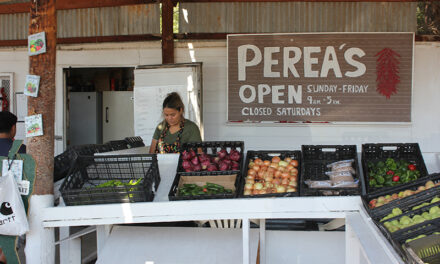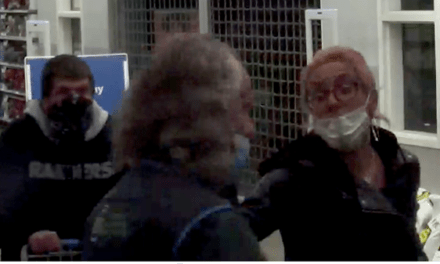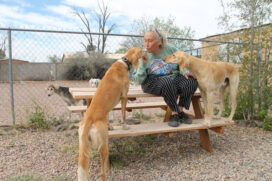
Frances Zeller, the museum coordinator for the Belen Harvey House Museum, is one of hundreds of public employees now working from home in the midst of the COVID-19 pandemic. Zeller is using this time to learn new skills for work and spend time relaxing with her Salukis.
Julia M. Dendinger | News-Bulletin photo
Home is where the heart is. That’s the old saying anyway.
With the COVID-19 public health emergency continuing, home has become one of the only places most people see these days.
People have turned their houses into a multitude of venues — a work space, classroom, gym, art studio, restaurant, yoga retreat and spa.
An introvert’s best life
In Los Chavez, Frances Zeller and her Salukis have adjusted easily to her spending more time at home.
The museum coordinator at the Belen Harvey House Museum, Zeller has been following the governor’s orders to stay at home and limit contact with others.
“I only go out once week, once every other week,” Zeller said. “Everyone jokes about how their dogs can’t figure out why they’re home all the time now. Mine are loving it.”
A self-proclaimed introvert, Zeller said staying put and working from home wasn’t extremely difficult. Add to that her compromised lungs and she’s more than willing to stick to her familiar surroundings.
“I also lost a good friend to this,” she said. “People are not paying attention. They are making this political and it’s not; this is real.”
As the disease began to creep towards New Mexico, working at the museum became a little unnerving.
“We have a sign-in sheet at the museum and people put where they’re from. We had someone from Italy right when they were having their meltdown,” she said. “It turned out she was an exchange student who’d been here for months, but it still got you to thinking.”
Shortly before travel restrictions were issued in the United Kingdom, the Harvey House had a visitor from England.
“People don’t think of us as an international destination, but we are,” Zeller said. “It started getting scary for my own health and that of the volunteers — most of them are older.”
When the city of Belen made the decision to close buildings to the pubic and eventually send employees home to work, Zeller met the new city manager, Andrew DiCamillo, for the first time.
“He really took charge and had a plan. I felt safe, like they had an idea of what’s going on,” she said. “I felt like they cared about us.”
The museum’s initial closure to the public gave Zeller and other employees a chance to work on projects they hadn’t found time for before. Now they are working from home and being an employee for a facility that’s very hands on, there are some limitations.
“I don’t have internet access. This whole pandemic has really brought to light how important health insurance and internet access are,” she said. “They’re a necessity, not a luxury.”
Using her cell phone and a tablet, if Zeller sits in just the right place at her house, she can get a signal. When she can get connected, Zeller has taken webinars and online courses on grant writing and marketing for nonprofits, as well as learning how tourist destinations can rebound after COVID-19.
“These are things I’d like to do to enhance my job at the Harvey House, but haven’t been able to find time for,” she said.
Zeller makes a point to call the museum volunteers every few days and check in, to make them feel “special, missed and important,” she said.
Other projects include personal ones, such as making purses and tote bags from antique rugs and upholstery fabric for future sale.
“My advice to people would be to be creative. Enjoy being at home. Slow down and watch something stupid on TV without feeling guilty.”
Recreation & preparation
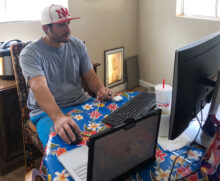
Los Lunas recreation supervisor Marcos Castillo is taking a few classes at UNM to pursue a degree in marketing while continuing his work remotely.
Submitted photo
Los Lunas recreation supervisor Marcos Castillo has been keeping busy at home. Because there aren’t any recreational activities put on by the village right now, Castillo has been managing the part-time employees duties.
“A lot of it has been getting creative with them. We have them out patrolling parks and making sure the barriers we put on the playgrounds are still intact,” Castillo said.
“Most of my time is spent making sure they’re still keeping busy and making sure they’re still relevant so they can still have a job right now.”
The Los Lunas Parks and Recreation Division has its own YouTube channel, which staff has been posting videos to in the wake of the recreation center being closed.
Castillo said they are planning the summer programming as if it is still going forward until they get word otherwise.
On top of that, Castillo and his wife are expecting their baby, which is due very soon.
“My wife is eight and three-quarter months pregnant. I’ve been able to stay home with her and be here with her at this time. It’s exciting and a little scary to be bringing a kid into the world right now,” Castillo said.
They plan to have the baby at a birthing center rather than a hospital, so he will be able to be part of the birthing process with his wife.
He’s also taking a few classes at The University of New Mexico to pursue a degree in marketing while working on some home improvement projects before the baby comes.
“I’m pretty routine-oriented so I’ve kind of tried to keep a similar work routine. The volume of work is obviously less than if I was in the office, and everything is kind of on hiatus right now but I’m trying to keep a semi-normal schedule as much as possible,” Castillo said.
A spring break without end
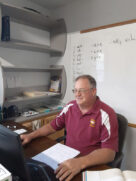
BHS chemistry teacher Stephen Boliver has taken his lessons virtual, thanks to a webcam and a homemade whiteboard.
Submitted photo
At first it was kind of OK. Spring break would be two weeks longer than anticipated.
“When it got real, we’re not going back at all, instead of just trying to pretend to keep organized for a while, I had to get organized,” said Belen High School teacher Stephen Boliver.
“Then reality became, ‘Wow, how do I really teach a lab science over video medium?’”
Fortunately, the semester was far enough along that students had already completed a lot of the hands-on lab work they needed.
“We happened to be in a good spot and I could kind of let that go,” Boliver said.
Using a piece of Formica counter top as a white board, the chemistry teacher set up a camera in a spare bedroom and dove into online classes.
“I draw organic structures and we practice naming them; they do practice work sheets,” he said. “It’s working. I think.”
Old habits are being readjusted in the age of COVID-19, Boliver said.
“That one-on-one interaction, walking up and shaking somebody’s hand has always been a part of life,” he said. “We had to stop and it’s been hard.”
Just as his classes have migrated online, so has the teaching community, through video meetings and text chats
“Our science department has always had a group text chat. We’re a very close department and chat by text nonstop, so that’s continued,” Boliver said.
Now without a separation between work and home, Boliver said he and his wife, who is also teaching from home, have to consciously get up, turn off devices and walk away.
“It’s far too easy to get stuck on the computer and stay all night,” he said. “I go out and take care of the dogs and chickens twice a day. I’ve cleaned the garage because there are no computers out there. I can’t imagine living in an apartment where you didn’t have outside space.”
The dynamic between Boliver and his wife has changed, he said. They’ve gone from leaving the house in the morning and not seeing each other all day to working just down the hallway from each other.
“We had times early in our marriage that cemented us together,” he said. “We’ve also survived a (house) remodel.”
Luckily, they have separate spaces to work in and two computers at home.
“I can see this being so hard on families with only one device and a parent trying to work from home, plus kids trying to do school work,” he said. “I have some high school students who are now primary caregivers for younger siblings; helping them do homework, feeding them, plus trying to get their own work done when their parents get home.”
New methods aside, Boliver said it’s important to establish and keep a routine, to get up and get ready for the day like it was any other day.
“I get dressed as I always have because I’m going to be on camera,” he said. “I’ve also tried to consciously stop what I’m doing and reach out to people if I get that mental prompting to call and check up on someone.
“It’s important right now to reach out to people I maybe don’t normally talk to. It’s good for me and good for them.”
Exhibit ‘conforms’ online
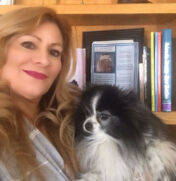
Los Lunas Museum of Heritage and Arts Museum Specialist Jan Micaletti now performs most of her job duties at home through webinars and social media.
Before the Los Lunas Museum of Heritage and Arts temporarily closed, museum specialist Jan Micaletti would conduct research, plan and curate museum exhibits, maintain records, coordinate tours and other educational programs and presentations for the community.
Now she performs most of these duties at home through webinars and social media.
“Working from home limits the interaction with museum visitors and employees,” Micaletti said. “Some days, working from home can have its struggles but overall I continue to have a positive outlook toward the situation.”
She is currently reviewing submissions for the museum’s online exhibit, “The Conform Project.” The theme of the project is based on life during the stay-at-home order due to COVID-19, and is meant to encourage local artists to keep creating and connecting through their art.
Micaletti said while she would prefer being at work under normal circumstances, she does enjoy the company of her dogs, Louie and Reese. She is recovering from a bout with pneumonia, so she is able to take this time to rest and continue recovering.
“It’s a blessing that I’m still able to work and recover,” Micaletti said. “It’s a little easier because I have everything I need around and I don’t have to step out for lunch or anything like that.”
She tries to replicate a similar work day at home, but said she enjoys the flexibility of the work hours.
“I find myself working a lot at night time, too, because I enjoy it. I just seem like more of a night person. I tend to work until 7 or 8 sometimes,” Micaletti said.
She looks forward to the time when things get better for everyone and some form of normalcy can continue.
“We have found ways to interact and communicate while still continuing to work from home. I am thankful that I am able to work from home and use technology to reduce the spread of the virus,” Micaletti said. “I’m hopeful that the curve will flatten and that we will all be able to go back to a normal lifestyle soon.”
Julia M. Dendinger began working at the VCNB in 2006. She covers Valencia County government, Belen Consolidated Schools and the village of Bosque Farms. She is a member of the Society of Professional Journalists Rio Grande chapter’s board of directors.

